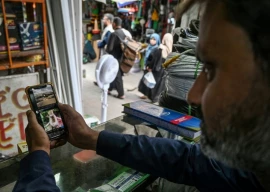
KARACHI:
The paradox is that we need to study the great artists as part of the process of becoming artists ourselves. But how can we tell if a work of art is truly original or merely a tweaked copy of someone else’s idea? Some people would argue that it’s all been said and done before.
These are precisely the questions that hit the campus of the Indus Valley School of Art and Architecture this week after students grumbled that their teachers, some of our top artists and architects, had ‘plagiarised’ ideas for their exhibition even though they were the very ones who discouraged it in class.
The Indus Valley School Gallery was a dismal sight on April 12 after its 21-chair exhibition held by the Institute of Architects Pakistan (IAP) to raise funds for its building, came to an end under a cloud of controversy. Nineteen of the chairs were sold but six were believed to be extremely close copies.
Anonymous commentators, mostly IVS students, stormed The Express Tribune website, hurling allegations at some of the most well known names in Pakistani design. The 3=1, the Challo! - Design Vision, the coil, the crescent, Rutta, and the R4Environment were among the chairs picked on in the comments along with visual evidence.
As expected, the architects responded in equal fashion. Indignant posts refuting the claims appeared in response to the student comments. Some people, such as Tariq Hasan, came forward with explanations - he posted a lengthy rebuttal complete with pictures on his Facebook page. Others simply maintained a stony silence, refusing to “stoop to the accusers’ level”.
Hasan, creator of ‘the crescent’ chair, was one of the architects who found himself in the middle of the controversy. A student went so far as to post a picture of a garden bench, which they said closely resembled his design. As one of the oldest teachers at IVS, Hasan told The Express Tribune that he was “really really livid”.
“I’ve been teaching since the inception of the school and a lot of the young professionals out there are my students,” he said. Interestingly, he claimed that “the one who started all of this was one of the students who was failed and made to repeat a grade or something similar.”
He argued that anyone deriving inspiration from the same object - in this case a crescent moon - would arrive at a similar conclusion. “A chair is a chair, and everyone will have something that will resemble something else, nothing is completely fresh or completely new.”
As far as the plagiarism allegations go, Hasan and Ahsan Najmi, one of the designers of 3=1 said the same thing: It doesn’t qualify as plagiarism if it is not an exact copy. “I’m not justifying it,” said Hasan, “but if the proportion changes, if anything changes, then it’s not considered plagiarism.”
Hasan feels wronged. As one of the architects who “pushed the school to this design level”, he feels he, and his fellow architects, have earned a right to respect and unquestionable credibility.
The students are divided. “This is just shameful and pathetic. The exhibition should be called 21+5 chairs,” read one of the comments on The Express Tribune’s website. “What is the use of such ‘inspiration’ when the exact same thing will be copied and produced! I am a student you know, and it is against the principles these particular designers have taught us!” said another.
The gossip around the IVS cafeteria was a little more sympathetic. While people some felt that the architects should be “bashed by the media”, others felt that perhaps they had been pressured into ‘copying’ the designs.
“We as students know what it is like to be forced to work something we don’t want to,” one student said. “What I’m assuming happened was that the organisers had 15 or so nice chairs but they felt 21 was a good number, so they got six more people who had a short time frame and were not really interested, but they couldn’t say no because it was for a good cause. I’m not saying they copied ideas, but they obviously didn’t work as hard on their concepts.”
Maria Aslam Hyder, one of the designers of the ‘4REnvironment’, a bathtub-cum-sofa, however, defended herself by saying that she had to make six chairs before coming up with one that worked. “I went through six bathtubs, they all fell apart during the design. I was jittery before the exhibit because I felt it would fall apart again. They (the students) have not bothered to take into account the time, money and effort that went into these designs.”
The bathtub chair is by no means an original design, and Hyder does not claim otherwise. “There must be thousands of them in western countries, just because we have not bothered with recycling yet, this is the first of its kind here. If tomorrow someone designs another chair from an old bathtub, I will not run after them, but would be proud to be the one who brought this concept of recycling to our country.”
Most of all, the fact that her work was about recycling meant that her idea could not have been new. “Anything to do with recycling cannot be plagiarism at all,” she said.
“The design of the chair has not come out from any internet influences,” said Ahsan Najmi, one of the architects who made ‘3=1’. “You can’t draw a conclusion like that without having some sort of design sense and certain years of experience to understand the difference between.”
Najmi said that no one was taking this matter lightly. “The three of us are very confident about our design and skill set, so much so that we are ready to challenge anyone willing to come to our office and explain to us how this is plagiarism,” he said.
For his part, Ahmed Mian commented on the website that: “This event aims to raise money for a great cause, for people like you and me who are the ultimate stakeholders of our country. Even if one buys a copy of a ‘good’ product, what is bad about it? China is doing exactly that, isn’t it?”
The exhibition’s curator, IAP vice chairman Arshad Faruqui was quick to defend the designers. “There is no such thing as 100 per cent original, everyone takes inspiration and every architect is responsible for their own design.”
When asked if the IAP was going to investigate the situation, Faruqui explained that, “the problem is that all the accusations are on Facebook and online under anonymity. We just wrapped up the exhibition, now we are going to look into the situation and see if we can take action against the people.”
Published in The Express Tribune, April 17th, 2011.
























































COMMENTS (35)
Comments are moderated and generally will be posted if they are on-topic and not abusive.
For more information, please see our Comments FAQ